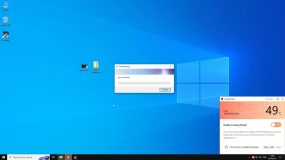What is Kernel32.dll?
Kernel32.dll is a critical system file used by the Windows operating system. As a dynamic link library (DLL), it plays a key role in managing memory, handling input and output operations, creating processes, and synchronizing system threads. Most applications that rely on Windows APIs interact with this file in some way.

Each time Windows boots, Kernel32.dll is loaded into a protected area of memory to ensure that no other processes interfere with its space. When the file is missing or becomes corrupted, users may encounter the dreaded kernel32.dll is missing error, preventing certain applications or system operations from working as expected.
What is the Kernel32.dll Not Found Error in Windows 10/11?
The Kernel32.dll Not Found error can occur at almost any time: while launching Windows, opening or closing apps, or performing specific tasks. The trigger is often unpredictable, which makes it more frustrating.
Common messages that may appear include:
- Explore caused an invalid page fault in module Kernel32.dll
- Explorer caused an invalid page fault in module Kernel32.dll
- Error in Kernel32.dll
- Commgr32 caused an invalid page fault in module Kernel32.dll
- Failed to get proc address for GetLogicalProcessorInformation (KERNEL32.DLL)
- [PROGRAM NAME] has caused an error in Kernel32.dll
- This application has failed to start because Kernel32.dll was not found. Re-installing the application may fix the problem.
In most situations, the root cause involves a corrupt or missing Kernel32.dll file, but other underlying issues—such as software conflicts, outdated system files, or hardware problems—could also be at play.
🛠️ If your Kernel32.dll issue is part of a broader system problem or you’ve encountered other kernel-related errors, these guides may help:
11 Methods to Deal with Kernel Mode Heap Corruption Blue Screen on Windows 10/11
How to Fix the UNEXPECTED KERNEL MODE TRAP Blue Screen Error on Windows 10/11
9 Ways to Resolve the Kernel32.dll Not Found Error in Windows 10/11
If you’re dealing with this error, try the following practical solutions to restore your system’s stability.
Reboot your PC
Sometimes, the error message is nothing more than a temporary system hiccup. A simple reboot may be enough to clear the issue and reload the file properly during the next boot sequence.
🛠️ Tip: If restarting doesn’t help, consider running Outbyte PC Repair—it can scan for underlying issues that may be causing recurring startup errors.
Reinstall the problematic program or app
If the error appears only when launching a specific program, reinstalling that application can help.
- Open the Start menu and go to Settings
- Navigate to Apps > Apps and Features
- Locate the affected app and click Uninstall
- Follow the instructions to remove it completely
- After uninstalling, download the latest version from the official site and reinstall it
This process can often restore any missing or corrupted files associated with the app, including Kernel32.dll.
Update your Windows 10/11 device
Running an outdated version of Windows may lead to compatibility issues or prevent system files like Kernel32.dll from functioning correctly. Regularly checking for updates ensures your system runs smoother.
To update:
- Click the Start menu > Settings
- Go to Update & Security
- Select the Windows Update tab
- Click Check for updates
Install any available updates and restart your system afterward.
Run an SFC scan
The System File Checker (SFC) tool is built into Windows and can automatically detect and repair corrupt or missing system files—including Kernel32.dll.
Steps:
- Press the Windows key and type
cmd - Right-click Command Prompt and choose Run as administrator
- Type
sfc /scannowand hit Enter - Wait for the scan to complete and follow any prompts
This scan may take several minutes but can be a very effective fix.
Repair the Thumbs.db file
In rare cases, a corrupted thumbs.db file can interfere with DLL files. To fix this:
- Press Windows + E to open File Explorer
- Navigate to folders that contain thumbnails
- Right-click
thumbs.db(if found) and select Delete - If deletion is not allowed, change the folder’s view (e.g., Details, List, Icons)
- Re-enable thumbnail view to recreate the file by clicking View > Thumbnails
Run a malware scan
Malware can tamper with or delete system files like Kernel32.dll. Use Windows Defender or a trusted antivirus tool to scan your entire system for threats.
You can also consider a lightweight security solution like Outbyte AVarmor, which can help remove threats and protect sensitive files without impacting system performance.
Update your device drivers
If the error appears during specific hardware activities—like printing or playing audio—outdated or incompatible drivers could be the problem. Updating them manually is possible, but not always easy.
You can simplify this process using Outbyte Driver Updater, which automatically scans for outdated drivers and installs compatible updates. This can help restore functionality tied to hardware-related DLL issues.
Use the CHKDSK utility
File system corruption on your hard drive can cause DLL-related problems. The built-in CHKDSK utility can check disk integrity and fix basic errors.
Here’s how to run CHKDSK:
- Press Windows + X and choose Command Prompt (Admin)
- Type
chkdsk C:(or replace “C” with the drive letter you want to scan) - Press Enter and let the scan complete
Windows may ask to schedule the scan for the next reboot if the disk is currently in use.
Resolve any hardware issues
If none of the above steps work, the issue might stem from faulty hardware—especially your hard drive. At this point, it’s advisable to consult a technician.
A professional can test your components, replace failing hardware, and help you reinstall Windows if needed. This is especially helpful if your system is older or has recently experienced power surges or physical damage.
Other common fixes for Windows users:
How to Fix Windows 10/11 Update Error Code 0x80073712?
How to Run the DISM.exe /Online /Cleanup-image /Restorehealth Tool
How to Fix a CLOCK_WATCHDOG_TIMEOUT BSOD in Windows 10/11
Error Copying File or Folder: “The Requested Value Cannot Be Determined”
FAQs
What does it mean when kernel32.dll is missing?
It means your system is unable to locate the Kernel32.dll file, which is necessary for running certain applications. This may be caused by corruption, deletion, or hardware/software conflicts.
Can I download Kernel32.dll from the internet to fix the error?
It’s not recommended. Downloading DLL files from unverified sources may put your system at risk. Instead, use tools like SFC or reinstall the affected application.
Will reinstalling Windows fix Kernel32.dll errors?
Yes, reinstalling Windows can fix Kernel32.dll issues, but it should be your last resort after trying the solutions above.
What causes the Kernel32.dll error in games or media players?
This usually points to a driver issue, especially if related to sound or graphics. Updating your drivers often resolves it.
Is Kernel32.dll a virus?
No. Kernel32.dll is a legitimate Windows system file. However, some malware disguises itself using similar filenames, so scanning your system is a good precaution.





